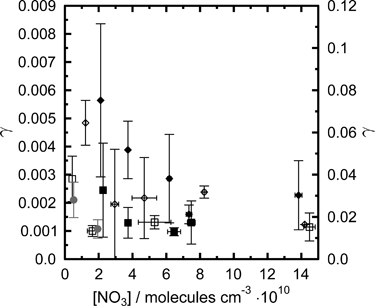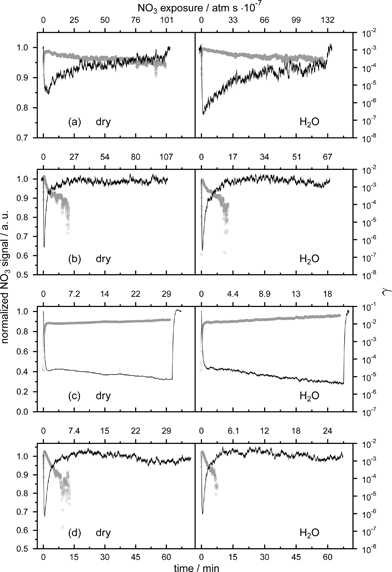Page 21050, abstract, line 6: “Within experimental uncertainties the uptake of NO3 was not sensitive to relative humidity levels of 30 and 60%.” is incorrect and should read “Within experimental uncertainties the uptake of NO3 was not sensitive to the presence of water vapour (<0.5% relative humidity).”
Page 21051, right column, line 37: “In addition, we examine the NO3 uptake as a function of relative humidity (RH) at 30 and 60%.” is incorrect and should read “In addition, we examine the NO3 uptake in the presence of water vapour (<0.5% relative humidity, RH)”.
Page 21052, left column, line 3: “For uptake experiments conducted at 30 and 60% RH, He was passed (0.2–0.5 l min¬1 standard temperature and pressure, STP) over a water reservoir held at room temperature, yielding a saturated He gas flow to adjust RH of the carrier gas.” is incorrect and should read “For uptake experiments conducted in presence of water vapour, He was passed (0.2–0.5 l min¬1 standard temperature and pressure, STP) over a water reservoir held at room temperature, yielding a saturated He gas flow to adjust RH of the carrier gas.”.
Page 21055, Table 2: 30 and 60 are combined to H2O. Please see corrected Table 2 below.
Page 21056, left column, line 9: “Within experimental uncertainties, does not change when increasing RH to 30 and 60%.” is incorrect and should read “Within experimental uncertainties, does not change in presence of water vapour corresponding to RH < 0.5%.”.
Page 21056, right column, line 14: “Similar to levoglucosan, within experimental uncertainties does not change when increasing RH to 30 and 60%.” is incorrect and should read “Similar to levoglucosan, within experimental uncertainties does not change when water vapour is present.”.
Page 21057, Fig. 5: Please see corrected Fig. 5 and the corresponding figure caption below.
Page 21057, left column, line 8: “Similar to the other organic substrates, within the experimental uncertainties does not change significantly when increasing RH to 30 and 60%.” is incorrect and should read “Similar to the other organic substrates, within the experimental uncertainties does not change significantly when water vapour is present.”.
Page 21057, left column, line 17: “Within the experimental uncertainties, does not change significantly when increasing RH to 30 and 60%.” is incorrect and should read “Within the experimental uncertainties, does not change significantly when water vapour is present.”.
Table 2 Reactive uptake coefficients, γ, of different oxidants with representative BBA surfaces at atmospherically relevant O2 and presence of water vapour determined at 298 K. “Up” and “Exp” represent uptake and exposure experiments, respectively, as described in the text. Uncertainty represents ±1σ. BDL indicates below detection limit.


Fig. 5 NO3 uptake coefficients, γ, of levoglucosan (squares), abietic acid (diamonds), and nitroguaiacol (circles) for dry conditions and in presence of water vapour (open symbols) as a function of gas-phase NO3 concentration. Vertical error bars represent 1σ from the mean in γ. Horizontal error bars represent 1σ from the mean in NO3 concentration. Grey symbols refer to the right y-axis.
Page 21057, left column, line 26: “Fig. 5 shows values derived from uptake and exposure experiments as a function of NO3 concentration for levoglucosan, abietic acid, and nitroguaiacol substrates at 0 and 30% RH.” is incorrect and should read “Fig. 5 shows values derived from uptake and exposure experiments as a function of NO3 concentration for levoglucosan, abietic acid, and nitroguaiacol substrates at dry conditions and in presence of water vapour.”.
Page 21057, left column, line 33: “For nitroguaiacol at 30% RH, the mixture substrates, and for all investigated organic substrates at 60% RH a clear trend of with NO3 concentrations was not observed.” is incorrect and should read “For the nitroguaiacol and mixture substrates exposed to water vapour, a clear trend of with NO3 concentrations was not observed.”.
Page 21057, right column, line 2: “Fig. 6 shows the change in normalized NO3 signal as a function of NO3 exposure, time, and RH due to NO3 uptake by the organic substrate in the presence of O2 at 298 K.” is incorrect and should read “Fig. 6 shows the change in normalized NO3 signal as a function of NO3 exposure, time, and presence of water vapour due to NO3 uptake by the organic substrate in the presence of O2 at 298 K.”.
Page 21058, Fig. 6: Please see corrected Fig. 6 and the corresponding figure caption below.

Fig. 6 NO3 exposure studies in presence of O2 for dry conditions and in presence of water vapour applying levoglucosan (a), abietic acid (b), nitroguaiacol (c), and mixture (d). The change in normalized NO3 signal as a function of time and NO3 exposure is shown as a black line. Grey open circles represent changes in experimentally derived γ. Time scale given for panel (d) is representative for all panels (x1-labels), however, each panel is associated with different NO3 exposures (x2-labels). Please note the scale for in panel (c) is different.
Page 21060, right column, line 13: “Within our experimental uncertainty the uptake of NO3 was not sensitive to relative humidity levels of 30 and 60%” is incorrect and should read “Within our experimental uncertainty the uptake of NO3 was not sensitive to the presence of water vapour (<0.5% RH).”.
Page 21060, right column, line 31: “The uptake of NO3 by levoglucosan, abietic acid, nitroguaiacol, and an atmospherically relevant mixture of those species as a function of NO3 exposure for 0, 30, and 60% relative humidity has been monitored, and corresponding changes in the reactive uptake coefficient have been determined.” is incorrect and should read “The uptake of NO3 by levoglucosan, abietic acid, nitroguaiacol, and an atmospherically relevant mixture of those species as a function of NO3 exposure for dry conditions and in presence of water vapour (<0.5% RH) has been monitored, and corresponding changes in the reactive uptake coefficient have been determined.”